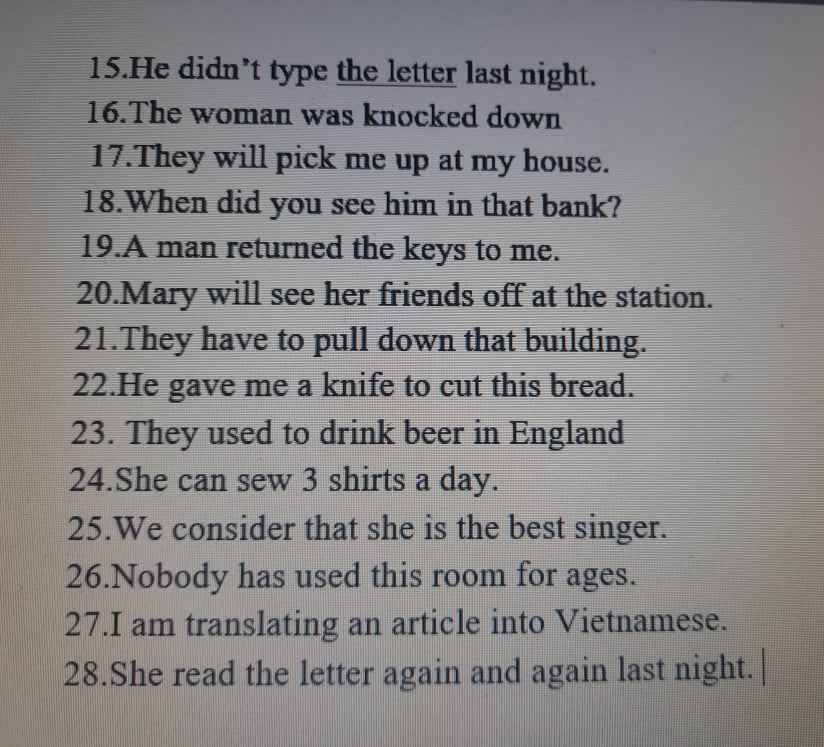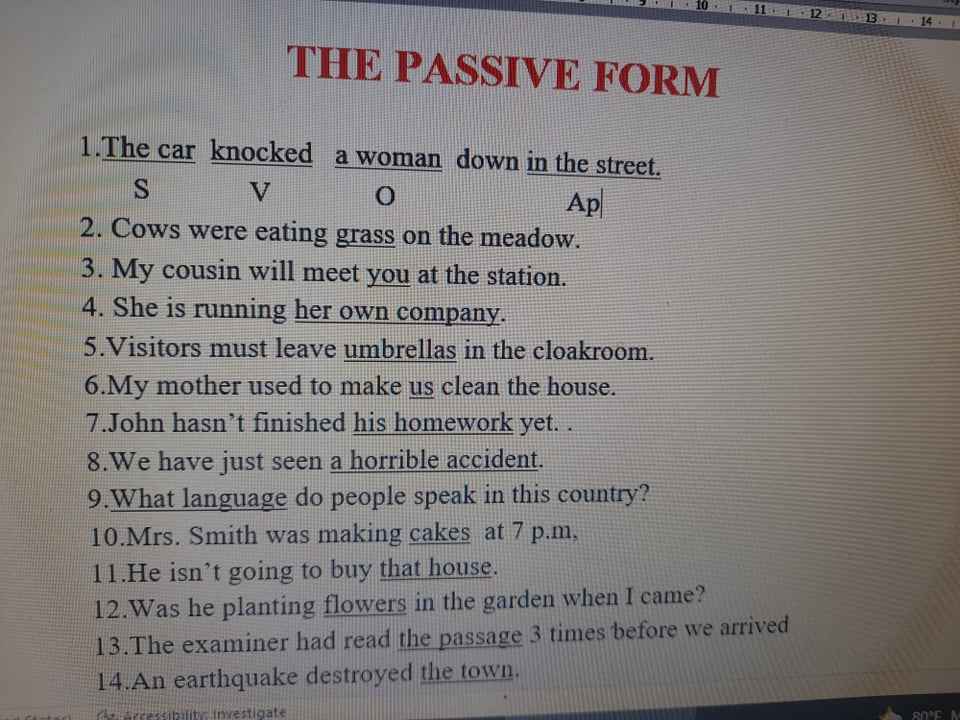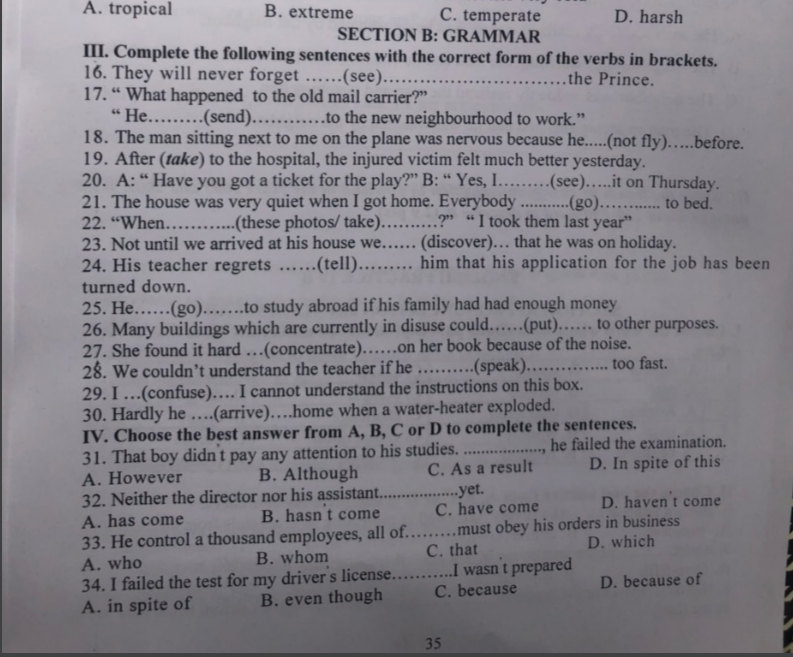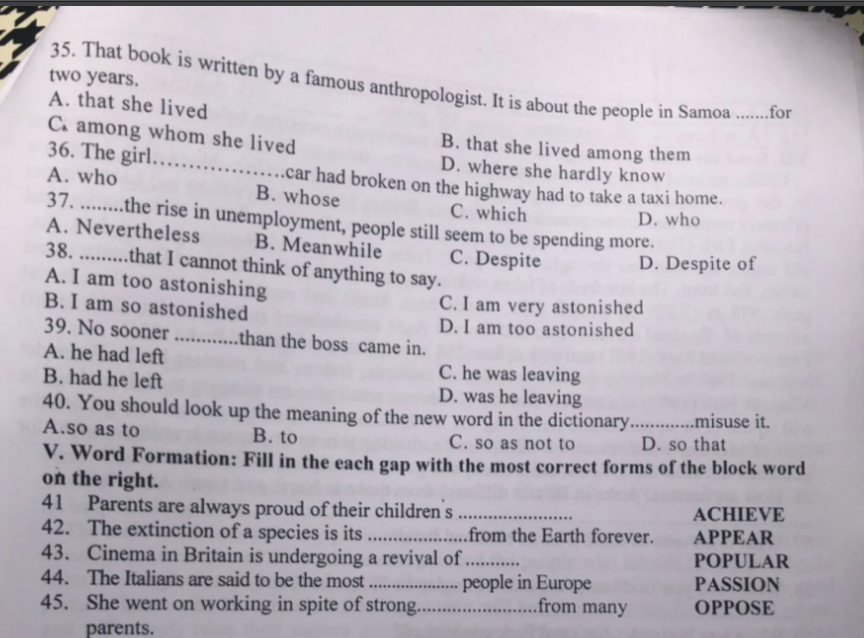
Hãy nhập câu hỏi của bạn vào đây, nếu là tài khoản VIP, bạn sẽ được ưu tiên trả lời.


sorry mình lười type quá cơ mà cái này là bước cơ bản quan trọng để bạn làm được bài chuyển đổi chủ động sang bị động ý ạ :))) nên bạn thử tham khảo thêm lí thuyết rồi làm thử xem sao ha, nếu bạn làm xong có thể gửi mình check cho =))

cái này như nếu bạn k biết thì bạn nên coi lại chớ cái này như căn bản lớp 9 rồi còn k biết thì thi chuyển cấp chết đó bạn ơi

1 cultural
2 generousity
3 natural
4 socialize
5 communication
6 speciality
7 reconcilly
8 populated
9 habitants
10 avoidable

16 seeing
17 was sent
18 hadn't flied
19 being taken
20 saw
21 had gone
22 were these photos taken
23 did we discovered
24 to tell
25 would have gone
26 be put
27 to concentrate
28 spoke
29 confused
30 had he arrived
31 C
32 A
33 B
34 C
35 C
36 B
37 C
38 C
39 B
40 C
41 achivement
42 disappearance
43 popularity
44 passionate
45 opposition


1. Because of studying hard, I passed the exam
2. Because of Hoa's richness, she could buy that house
3. Because of bad grades, she failed the University entrance exam
4. Because of the accident, I was late
5. Because of the terrible traffic, we didn't arrive until 6 o'clock

Ao Dai the a traditional dress of Vietnam. It is one of the symbols of Vietnam. When one hears about Vietnam, the word “Ao Dai” will most probably be mentioned.
Early versions of the “Ao Dai” date back to 1744 when Lord Vu Vuong of the Nguyen Dynasty decided both men and women should wear an outfit of pants and a gown that buttoned down the front. What wasn’t, until 1930 that “Ao Dai”appear similar to what it looks today. Now, Men wear it less, generally only on ceremonial occasions such as weddings or funerals. During the 1950s two tailors in Saigon started producing “Ao Dai”with raglan sleeves. This creates a diagonal seam running from the collar to the underarm. This style is still preferred today
“Ao Dai”is made individually to fit each customer's shape to create the most flasttering look. Its body-hugging top flows over wide trousers that brush the floor. The pants should reach the soles of the feet and flow along the floor. Splits in the gown extend well above waist height and make it comfortable and easy to move in.
Comfortability is always taken into account for fashions and beauty. Tailors must be skills so as to ensure the wearer has freedom of movement. Despite it being a long robe, “Ao Dai” is cool to wear. Synthetic or silk fabrics are best to use being they do not crush and dry quickly. For this reason “Ao Dai” is a practical uniform for daily wear.
The color can show the wearer's age and status. Young girls wear pure white, fully-lined outfits symbolizing their purity. Older but unmarried girls move into soft pastel shades. Only married women wear “Ao Dai”in strong, rich colors, usually over white or black pants. “Ao Dai”is rarely seen in places where manual work is practiced. In the nineties the Ao dai become popular again. It has become standard and common attire for female students as well and staff at offices and hotels. Ao dai nowadays is very popular with different designs and colors. “Ao Dai”has become the most preferred dress for formal occasions and traditionally ceremonies.









